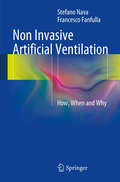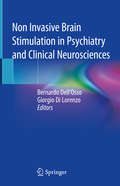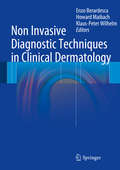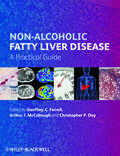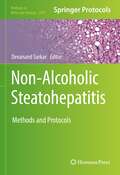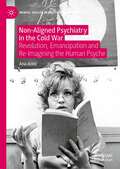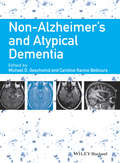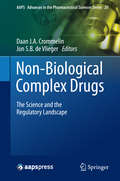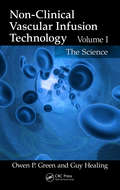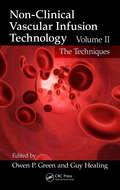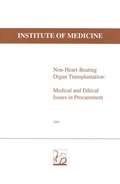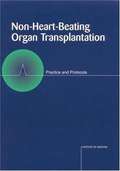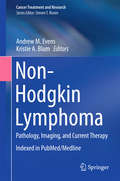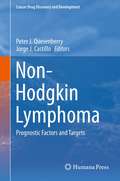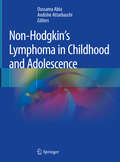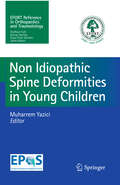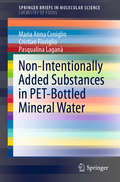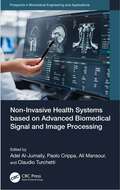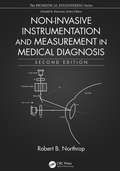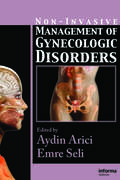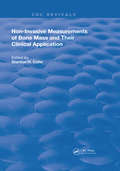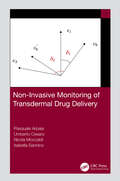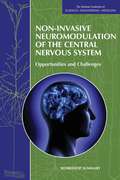- Table View
- List View
Non Invasive Artificial Ventilation
by Stefano Nava Francesco FanfullaOver the last two decades, the increasing use of noninvasive ventilation (NIV) has reduced the need for endotracheal ventilation, thus decreasing the rate of ventilation-induced complications. Thus, NIV has decreased both intubation rates and mortality rates in specific subsets of patients with acute respiratory failure (for example, patients with hypercapnia, cardiogenic pulmonary edema, immune deficiencies, or post-transplantation acute respiratory failure). Despite the increased use of NIV in clinical practice, there is still a need for more educational tools to improve clinicians' knowledge of the indications and contraindications for NIV, the factors that predict failure or success, and also what should be considered when starting NIV. This book has the dual function of being a "classical" text where the major findings in the literature are discussed and highlighted, as well as a practical manual on the tricks and pitfalls to consider in NIV application by both beginners and experts. For example, setting the ventilatory parameters; choosing the interfaces, circuits, and humidification systems; monitoring; and the "right" environment for the "right" patient will be discussed to help clinicians in their choices.
Non Invasive Brain Stimulation in Psychiatry and Clinical Neurosciences
by Bernardo Dell’Osso Giorgio Di LorenzoThis book presents the state of the art regarding the use of non-invasive brain stimulation (TMS and tDCS) in the research and treatment of neuropsychiatric disorders. The contributions, all of which were prepared by internationally recognized experts in the field, are divided into two main sections (for TMS and tDCS, respectively) across diagnoses, following an introductory section on the mechanisms of action and neurophysiological background. Neuropsychological perspectives and approaches are provided as well. The book is ultimately intended to offer a unique, integrated approach to the use of non-invasive brain stimulation across the clinical neurosciences, providing a comprehensive and updated perspective that will benefit psychiatrists, neurologists, clinical psychologists and neurophysiologists alike.
Non Invasive Diagnostic Techniques in Clinical Dermatology
by Howard I. Maibach Enzo Berardesca Klaus-Peter WilhelmThis book is a comprehensive but compact guide to the latest technical and technological developments in the growing field of non invasive diagnosis in clinical dermatology. Information is provided on the practical and technical characteristics of a wide range of equipment and methods for in vivo measurements that aid in the investigation of skin function, the evaluation of topically applied products and the monitoring of skin disease. Individual sections are devoted to imaging techniques, skin analysis, superficial skin analysis, skin mechanics, water and stratum corneum hydration and erythema and blood flow. All of the authors are experts in the field, with detailed knowledge of the techniques they describe. Non Invasive Diagnostic Techniques in Clinical Dermatology will be of value for all dermatologists, whether they are engaged in delivering patient care or in research programs, for cosmetic scientists and for biologists involved in skin research and product assessment.
Non-Alcoholic Fatty Liver Disease
by Geoffrey C. Farrell Christopher P. Day Arthur J. McculloughThe sharp rise in cases of Non-alcoholic fatty liver disease is fast becoming one of the major concerns for hepatologists worldwide. This comprehensive clinical guide explains how to diagnose NAFLD and manage patients according to the best standards of care. Contributors from the world's leading institutions concentrate on patient care, drawing on their extensive experience.
Non-Alcoholic Fatty Liver Disease: A 360-degree Overview
by Elisabetta BugianesiThe goal of this book is to promote awareness of non-alcoholic fatty liver disease (NAFLD) – which is rapidly replacing viral hepatitis as the leading cause of chronic liver disease in Europe, North and South America and Asia – and to share the latest information on evolving approaches to diagnosis and treatment. The book offers a comprehensive overview of the current topics of interest in the field, and provides clinical guidance on NAFLD through a multidisciplinary approach based on the latest scientific understanding of this multisystemic disease, involving the expertise of specialists including hepatologists, diabetologists, and cardiologists. The respective contributions address various aspects, including the newly released international guidelines, novel diagnostic modalities, and new experimental drugs. The work will appeal to a broad readership, from residents in internal medicine to specialists.
Non-Alcoholic Steatohepatitis: Methods and Protocols (Methods in Molecular Biology #2455)
by Devanand SarkarThis volume contains a comprehensive collection of laboratory protocols used by researchers to analyze varied aspects of non-alcoholic steatohepatitis (NASH). The chapters in this book cover topics such as methods for histological diagnosis of NASH; the purpose of generating an in vivo NASH model; protocols for isolating hepatocytes and Kupffer cells, bone marrow derived macrophages, and adipocytes; techniques to develop human pluripotent stem cells-derived liver organoids; single-cell and RNA-sequencing; and a description of how to extract exosomes and exosomal miRNAs from mesenchymal stem cells. Written in the highly successful Methods in Molecular Biology series format, chapters include introductions to their respective topics, lists of the necessary materials and reagents, step-by-step, readily reproducible laboratory protocols, and tips on troubleshooting and avoiding known pitfalls. Thorough and practical, Non-Alcoholic Steatohepatitis: Methods and Protocols is a valuable resource for new and experiences investigators studying NASH, and serves as an essential reference on NASH for basic and clinical researchers and students.
Non-Aligned Psychiatry in the Cold War: Revolution, Emancipation and Re-Imagining the Human Psyche (Mental Health in Historical Perspective)
by Ana AntićThis book explores the relationship between socialist psychiatry and political ideology during the Cold War, tracing Yugoslav ‘psy’ sciences as they experienced multiple internationalisations and globalisations in the post-WWII period. These unique transnational connections – with West, East and South – remain at the centre of this book. The author argues that the ‘psy’ disciplines provide a window onto the complications of Cold War internationalism, offering an opportunity to re-think postwar Europe's internal dynamics. She tells an alternative, pan-European narrative of the post-1945 period, demonstrating that, in the Cold War, there existed sites of collaboration and vigorous exchange between the two ideologically opposed camps, and places like Yugoslavia provided a meeting point, where ideas, frameworks and professional and cultural networks from both sides of the Iron Curtain could overlap and transform each other. Moreover, the book offers the first analysis of East European psychiatrists’ contacts with and contributions to the decolonizing world, exploring their participation in broader political discussions about decolonization, anti-imperialism and non-alignment. The Yugoslav brand of East-West psychoanalysis and psychotherapy bred a truly unique intellectual framework, which enabled psychiatrists to think through a set of political and ideological dilemmas regarding the relationship between individuals and social structures. This book offers a thorough reinterpretation of the notion of ‘communist psychiatry’ as a tool used solely for political oppression, and instead emphasises the political interventions of East European psychiatry and psychoanalysis.
Non-Alzheimer's and Atypical Dementia
by Michael D. Geschwind Caroline Racine BelkouraDementia is the most common type of neurodegenerative disorder. Non-Alzheimer's and Atypical Dementia concentrates on each form of dementia individually, considering symptoms, diagnosis and treatment Focuses on non-Atypical Dementia Multidisciplinary approach to diagnosis and management Allows development of management and care plan strategies Practical approach including case studies Written by a world-renowned editorial team
Non-Biological Complex Drugs
by Daan J.A. Crommelin Jon S. B. de VliegerThe rise of bio- and nano-technology in the last decades has led to the emergence of a new and unique type of medicine known as non-biological complex drugs (NBCDs). This book illustrates the challenges associated with NBCD development, as well as the complexity of assessing the effects of manufacturing changes on innovator and follow-on batches of NBCDs. It also touches upon proven marketing authorization requirements for biosimilars that could be effective in evaluating follow-on NBCDs, including a demonstration of control over the manufacturing process and a need for detailed physico-chemical characterization and (pre)clinical tests. This book is meant to be used for years to come as a standard reference work for the development of NBCDs. Moreover, this book aims to stimulate discussions and further our thinking to ensure that decisions regarding the approval of complex drugs are made with relevant scientific data on the table.
Non-Clinical Vascular Infusion Technology, Volume I: The Science
by Owen P. Green Guy HealingIntravenous infusion is a necessary mode of delivery for many pharmaceuticals currently on the market or undergoing clinical trials. The technique of prolonged intravenous delivery in conscious, free-moving animal models has broadened the opportunity to study and evaluate the safety and efficacy of these therapeutic products. For the first time, th
Non-Clinical Vascular Infusion Technology, Volume II: The Techniques
by Owen P. Green and Guy HealingIntravenous infusion is a necessary mode of delivery for many pharmaceuticals currently on the market or undergoing clinical trials. The technique of prolonged intravenous delivery in conscious, free-moving animal models has broadened the opportunity to study and evaluate the safety and efficacy of these therapeutic products. With contributions fro
Non-Heart-Beating Organ Transplantation: Medical and Ethical Issues in Procurement
by Roger HerdmanNon-heart-beating donors (individuals whose deaths are determined by cessation of heart and respiratory function rather than loss of whole brain function) could potentially be of major importance in reducing the gap between the demand for and available supply of organs for transplantation. Prompted by questions concerning the medical management of such donors--specifically, whether interventions undertaken to enhance the supply and quality of potentially transplantable organs (i.e. the use of anticoagulants and vasodilators) were in the best interests of the donor patient--the U.S. Department of Health and Human Services asked the Institute of Medicine to examine from scientific and ethical points of view "alternative medical approaches that can be used to maximize the availability of organs from [a] donor [in an end-of-life situation] without violating prevailing ethical norms...."This book examines transplantation supply and demand, historical and modern conceptions of non-heart-beating donors, and organ procurement organizations and transplant program policies, and contains recommendations concerning the principles and ethical issues surrounding the topic.
Non-Heart-Beating Organ Transplantation: Medical and Ethical Issues in Procurement
by Roger Herdman Study DirectorNon-heart-beating donors (individuals whose deaths are determined by cessation of heart and respiratory function rather than loss of whole brain function) could potentially be of major importance in reducing the gap between the demand for and available supply of organs for transplantation. Prompted by questions concerning the medical management of such donors--specifically, whether interventions undertaken to enhance the supply and quality of potentially transplantable organs (i.e. the use of anticoagulants and vasodilators) were in the best interests of the donor patient--the U.S. Department of Health and Human Services asked the Institute of Medicine to examine from scientific and ethical points of view "alternative medical approaches that can be used to maximize the availability of organs from [a] donor [in an end-of-life situation] without violating prevailing ethical norms...."This book examines transplantation supply and demand, historical and modern conceptions of non-heart-beating donors, and organ procurement organizations and transplant program policies, and contains recommendations concerning the principles and ethical issues surrounding the topic.
Non-Heart-Beating Organ Transplantation: Practice and Protocols
by Committee on Non-Heart-Beating Transplantation II: The Scientific Ethical Basis for Practice ProtocolsThe National Academies Press (NAP)--publisher for the National Academies--publishes more than 200 books a year offering the most authoritative views, definitive information, and groundbreaking recommendations on a wide range of topics in science, engineering, and health. Our books are unique in that they are authored by the nation's leading experts in every scientific field.
Non-Hodgkin Lymphoma
by Andrew M. Evens Kristie A. BlumThis book provides clinical practitioners and the research community with detailed information on the diagnosis, prognosis, and treatment of non-Hodgkin lymphoma, taking into account the significant growth in knowledge including multiple therapeutic advances that have been achieved over the past 5-10 years. The work is subdivided into epidemiology, pathogenesis, pathology, imaging, and therapy of the non-Hodgkin lymphomas. The full range of therapeutic options are examined according to the major subtypes of non-Hodgkin lymphoma and the most up-to-date information is provided on current standard treatment options, including stem cell transplantation as well as new cutting-edge therapeutics.
Non-Hodgkin Lymphoma
by Jorge J. Castillo Peter J. QuesenberryThis book will be the first that focuses on solely on model organisms for lymphoma. It's editors are internationally recognized in the field.
Non-Hodgkin's Lymphoma in Childhood and Adolescence
by Oussama Abla Andishe AttarbaschiThis text provides a state-of-the-art overview on Non-Hodgkin's lymphoma (NHL) in children and adolescents. The volume is divided into seven sections, each of which focuses on a critical component of pediatric NHL, including history and epidemiology, pathology and molecular biology, disease evaluation and response, common and rare sub-types of NHL, and current and novel treatment strategies. The text also comprehensively reviews the late effects of treatment, quality of patient life, and NHL treatment in countries with limited resources.Written by experts in the field, Non-Hodgkin's Lymphoma in Childhood and Adolescence is a valuable resource for clinicians and practitioners who treat children and adolescents with NHL.
Non-Idiopathic Spine Deformities in Young Children
by Muharrem YaziciNon-idiopathic early onset scoliosis represents a true challenge to the physician due to the significance of the ongoing growth of the spine, the risk of curve progression, and the risk of pulmonary insufficiency. A comprehensive review of the growth mechanisms of spine in infancy forms the basis of the book. Clinical evaluation and imaging of early onset scoliosis contribute to the diagnostic overview. The main causes of non-idiopathic early onset scoliosis are briefly described in the second part of the book. The last group of chapters presents the conservative and surgical treatments that are available along with their results, chances and challenges. This comprehensive guide is an opportunity for every specialist involved in the treatment of these severe deformities, to obtain an update of the actual trends and knowledge in the field in a one-point reference.
Non-Intentionally Added Substances in PET-Bottled Mineral Water (SpringerBriefs in Molecular Science)
by Pasqualina Laganà Maria Anna Coniglio Cristian FioriglioThis book discusses a major issue in the food contact materials industry: non-intentionally added substances (NIAS), and their impact on PET-bottled water. NIAS are chemical compounds that are present in food contact materials but have not been added for technical reasons during the production process, and consumers are usually unaware of their presence. NIAS can include decomposition or degradation products, impurities in the raw materials, unwanted by-products or contaminants from recycling processes, and they pose a challenge for packaging manufacturers.In Europe, the EU Regulations No. 1935/2004 and 10/2011 set out, respectively, the general principles of safety and inertness for all packaging materials, and rules on the composition of plastic food-contact materials. Among the plastics commonly used for bottled water and other non-alcoholic refreshment beverages, polyethylene terephthalate (PET) is the most favoured thanks to its chemical and physical stability, its transparency, low weight and good recyclability. Further, very few additives are used for its manufacture. Nonetheless, due to the complex formulations of polymers, processes and storage, NIAS can also be found in PET-bottled water, with potential cancerogenic or toxic effects.This book provides an overview of the European regulation of NIAS in plastic packaging materials, offering insights into their chemical composition in PET-bottled water. Lastly, it provides a useful discussion on NIAS and their toxicity.
Non-Invasive Health Systems based on Advanced Biomedical Signal and Image Processing (Prospects in Biomedical Engineering and Applications)
by Ali Mansour Adel Al-Jumaily Paolo Crippa Claudio TurchettiThis book contains up-to-date noninvasive monitoring and diagnosing systems closely developed by a set of scientists, engineers, and physicians. The chapters are the results of different biomedical projects and theoretical studies that were coupled by simulations and real-world data.Non-Invasive Health Systems based on Advanced Biomedical Signal and Image Processing provides a multifaceted view of various biomedical and clinical approaches to health monitoring systems. The authors introduce advanced signal- and image-processing techniques as well as other noninvasive monitoring and diagnostic systems such as inertial sensors in wearable devices and novel algorithm-based hybrid learning systems for biosignal processing. The book includes a discussion of designing electronic circuits and systems for biomedical applications and analyzes several issues related to real-world data and how they relate to health technology including ECG signal monitoring and processing in the operating room. The authors also include detailed discussions of different systems for monitoring various conditions and diseases including sleep apnea, skin cancer, deep vein thrombosis, and prosthesis controls. This book is intended for a wide range of readers including scientists, researchers, physicians, and electronics and biomedical engineers. It will cover the gap between theory and real life applications.
Non-Invasive Instrumentation and Measurement in Medical Diagnosis (Biomedical Engineering)
by Robert B. NorthropNon-Invasive Instrumentation and Measurement in Medical Diagnosis, Second Edition discusses NIMD as a rapidly growing, interdisciplinary field. The contents within this second edition text is derived from Professor Robert B. Northrop’s experience teaching for over 35 years in the Biomedical Engineering Department at the University of Connecticut. The text focusses on the instruments and procedures which are used for non-invasive medical diagnosis and therapy, highlighting why NIMD is the preferred procedure, whenever possible, to avoid the risks and expenses associated with surgically opening the body surface. This second edition also covers a wide spectrum of NIMD topics including: x-ray bone densitometry by the DEXA method; tissue fluorescence spectroscopy; optical interferometric measurement of nanometer tissue displacements; laser Doppler velocimetry; pulse oximetry; and applications of Raman spectroscopy in detecting cancer, to name a few. This book is intended for use in an introductory classroom course on Non-Invasive Medical Instrumentation and Measurements taken by juniors, seniors, and graduate students in Biomedical Engineering. It will also serve as a reference book for medical students and other health professionals intrigued by the topic. Practicing physicians, nurses, physicists, and biophysicists interested in learning state of the art techniques in this critical field will also find this text valuable. Non-Invasive Instrumentation and Measurement in Medical Diagnosis, Second Edition concludes with an expansive index, bibliography, as well as a comprehensive glossary for future reference and reading.
Non-Invasive Management of Gynecologic Disorders
by Emre Seli Aydin AriciNon-invasive options for the management of gynecologic conditions continue to grow in popularity, as they offer considerable benefits in reduced patient stress, hospitalization time, and cost. Non-invasive Management of Gynecologic Disorders provides an informative, concise, and highly practicable resource for the diagnosis and management of gyneco
Non-Invasive Measurements of Bone Mass & Their Clinical Application (Routledge Revivals)
by Stanton H. CohnFirst Published in 1981, this book offers a full, comprehensive guide to measuring bone mass. Carefully compiled and filled with a vast repertoire of notes, diagrams, and references this book serves as a useful reference for students of osteology, and other practitioners in their respective fields.
Non-Invasive Monitoring of Transdermal Drug Delivery
by Pasquale Arpaia Umberto Cesaro Nicola Moccaldi Isabella SanninoThe book presents an innovative technology based on injection of a very weak current to trace the quantity of a drug carried immediately after the administration. The book makes the reader familiar with the technology, from the conception through the design of the instrument, up to the preliminary clinical applications. In the first chapter, the method of transdermal drug delivery and the use of impedance spectroscopy in the dermatological field are presented. The second chapter describes a screening measurement campaign aimed at proving the feasibility of the assessment method and identifying the bandwidth of interest. The prototyping, validation and characterization of an instrument to measure the amount of drug delivered (DUSM: Drug Under Skin Meter) are presented in chapter three. In the fourth chapter three experimental campaigns, based on the electrical analysis of the biological tissue behavior due to the drug delivery, are reported: (i) laboratory emulation on eggplants, (ii) ex-vivo tests on pig ears, and finally (iii) in-vivo tests on human volunteers. In the fifth chapter a behavioral model, based on Finite Elements and Partial Differential Equation, of an impedance-based measurement system for assessing the drug released under the skin, during transdermal delivering, is proposed. The last chapter is dedicated to present a campaign in order to prove the suitability for insulin therapy applications. This book is intended for biomedical engineers, biomedical engineering students, operators working in the field of biomedical instrumentation, biotechnologists, and technicians of transdermal vehiculation.
Non-Invasive Neuromodulation of the Central Nervous System: Workshop Summary
by Lisa BainBased on advances in biotechnology and neuroscience, non-invasive neuromodulation devices are poised to gain clinical importance in the coming years and to be of increasing interest to patients, clinicians, health systems, payers, and industry. Evidence suggests that both therapeutic and non-therapeutic applications of non-invasive neuromodulation will continue to expand in coming years, particularly for indications where treatments are currently insufficient, such as drug-resistant depression. Given the growing interest in non-invasive neuromodulation technologies, the Institute of Medicine's Forum on Neuroscience and Nervous System Disorders convened a workshop, inviting a range of stakeholders - including developers of devices and new technologies, researchers, clinicians, ethicists, regulators, and payers - to explore the opportunities, challenges, and ethical questions surrounding the development, regulation, and reimbursement of these devices for the treatment of nervous system disorders as well as for non-therapeutic uses, including cognitive and functional enhancement. This report highlights the presentation and discussion of the workshop.
